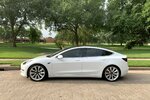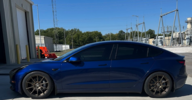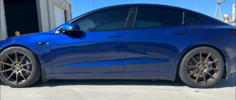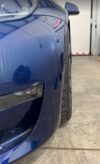Hey guys, so I just lowered my 3P with H&R lowering springs but came across a thread saying that the OEM struts aren’t made to handle lowering springs.
In the suspension, specific shocks are picked to dampen the isolation from the specific springs, selected for a specific vehicle application.
If you increase the stiffness of springs, or shorten their length (aka drop the car), you would want to re-evaluate your selection of shocks.
I have not taken apart the 3P suspension (mine is a daily driver, and already scrapes a few driveways around where I live), but have done that with most of my other cars.
The most likely answer is that your suspension is bouncing off the shocks' rubber bump stops. Those are round rubber pucks installed around the shock piston that soften the impact when it runs out of travel. In other words, you are no longer using the shocks as designed. You have exhausted their amplitude of travel, and are hitting the bump stops that limit the range of travel.
You could remove the bump stops or shorten them to regain shock's dampening ability. But depending on how much you dropped the car, you may just increase the chance of shocks piston slamming into the shock housing, and self-destructing.
My car definitely feels more bouncy than stock, which I’m okay with but I don’t want to destroy my stock struts. [...] am I ok to continue driving on my current setup of stock struts on H&R springs, or should I switch to coil overs sometime in the near future?
It's up to you.
Only you can tell how tolerable (or not) the bouncy ride is. I would not worry about destroying shocks too much (they are a throw away item), unless you plan to re-install the OEM springs in the future (when selling the car).
For sure coilovers are the way to go.
There is nothing "for sure" in life, let alone in suspension upgrades.
Everything comes at a price, and represents a compromise of some sort.
Let's get the terminology straight first.
Coilover means simply that the shock is mounted by threading it inside the spring. That's all there is to it.
That is actually
not the best configuration, but is the most compact and low cost solution that has been adopted by the auto-industry. OEM front suspension setup on Model 3 is a coilover. Rear is multi-link. Forcing the rear into coilover configuration is not necessarily and improvement!
Aftermarket coil-overs simply means that someone has assembled (presumably) well matched pair of springs + shocks that go well together. Consequently, you will be paying more for more components, and someone else's R&D in pairing them.
One can achieve an equal, or even better, outcome by pairing the right set of springs and shocks on your own. You just need to know what you are doing. Or buy the pairs that someone else has put together for you.
Coilover, or otherwise.
Additionally you can actually adjust the ride height in all of their kits including the non-adjustable comfort kit (the shocks are not adjustable but the right height is).
That is a common and misleading selling point advertised by some aftermarket coilover vendors.
While some shock housings have threaded nuts that would allow you to change the ride height, that is not something that you are likely to do in real life. For one thing, changing ride height on one corner effects weight distribution and handling on other corners. So you really need to be doing that over a set of 4 scales under each wheel. Very few car guys own those, never mind a typical Tesla owner.
Secondly. changing ride height effects suspension geometry, so you would need to re-align the car after each meaningful height change. OEM suspension does not allow camber adjustment, so now you need to buy additional suspension pieces to actually achieve the desired alignment settings. Again doable, but gets progressively more expensive, and alignment is not a DYI activity in your garage.
I've BTDT, and paying $200+ for proper alignment after fooling around with ride height gets old, fast.
So set your ride height, align the car, and forget about touching it again.
Changing dampener settings, OTOH, is relatively easily and fun. Especially if you have DA (dual adjustable) shocks - one adjustment knob for rebound, and another for compression.
HTH,
a







